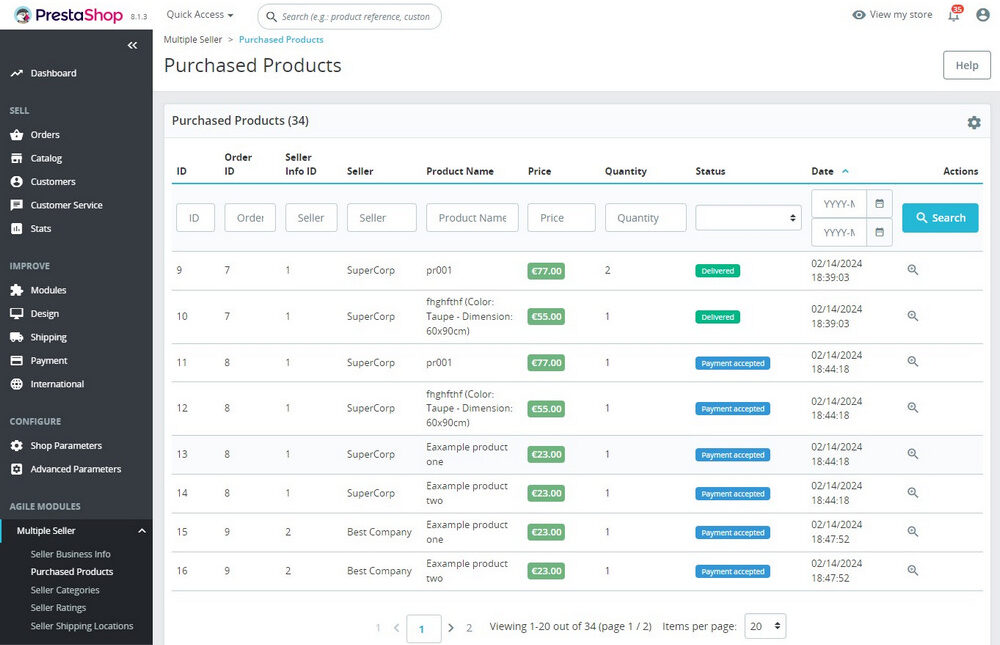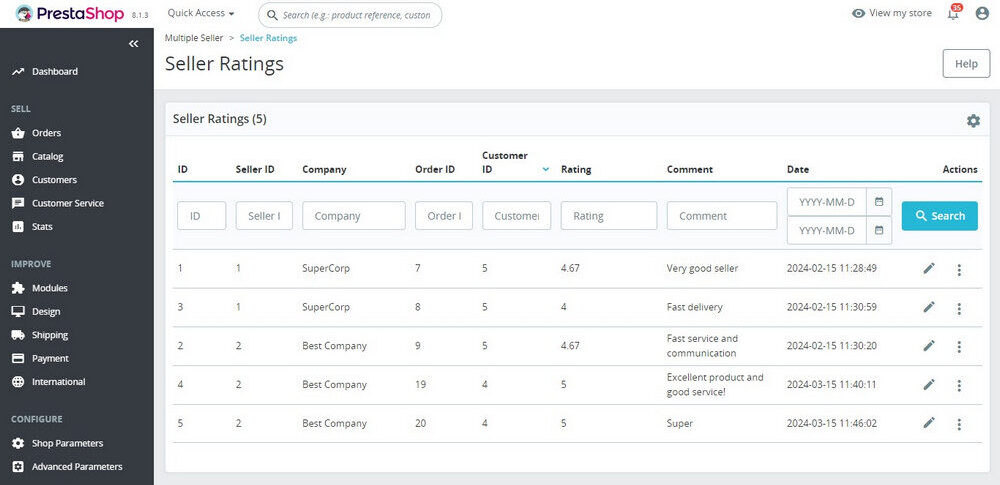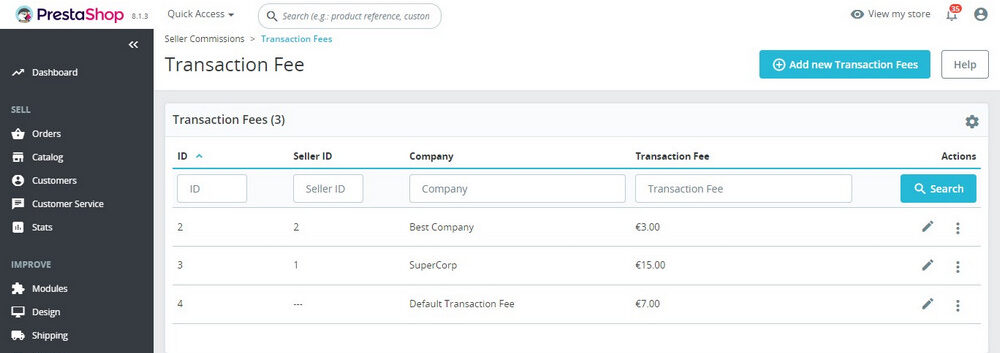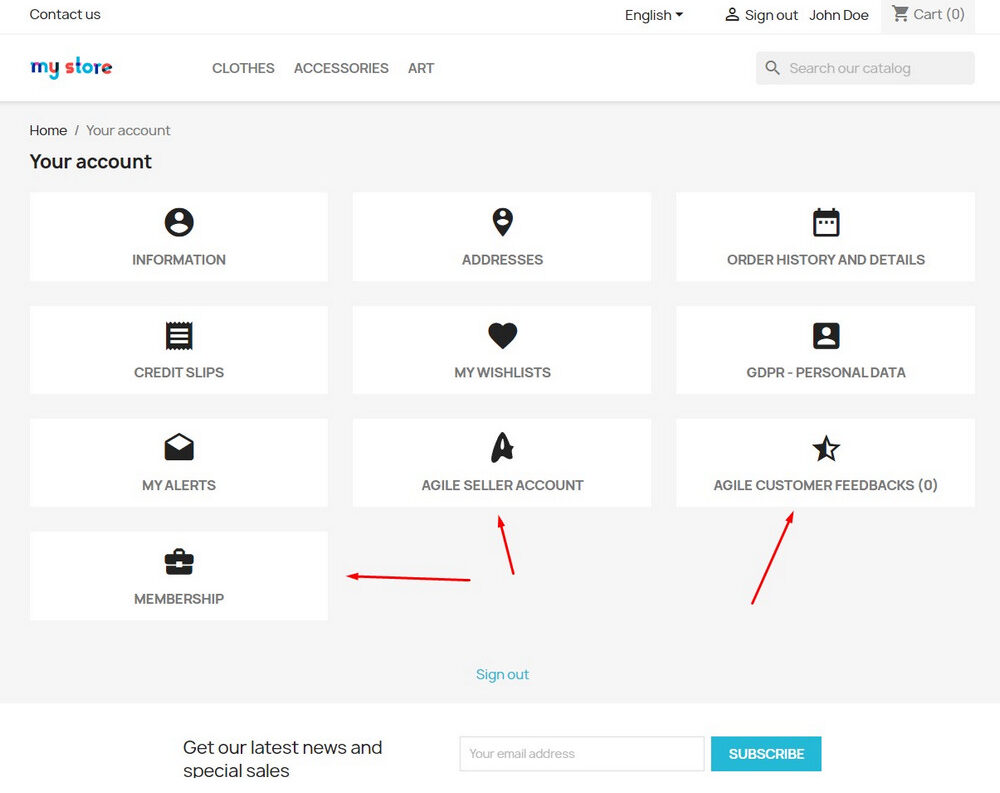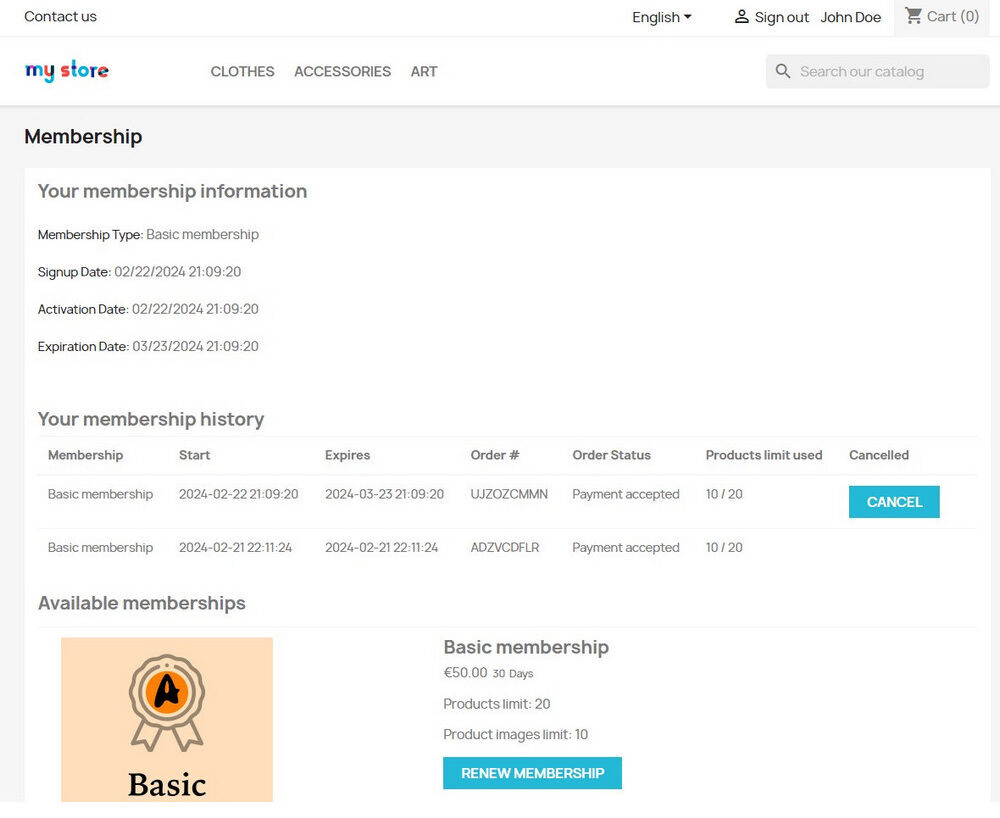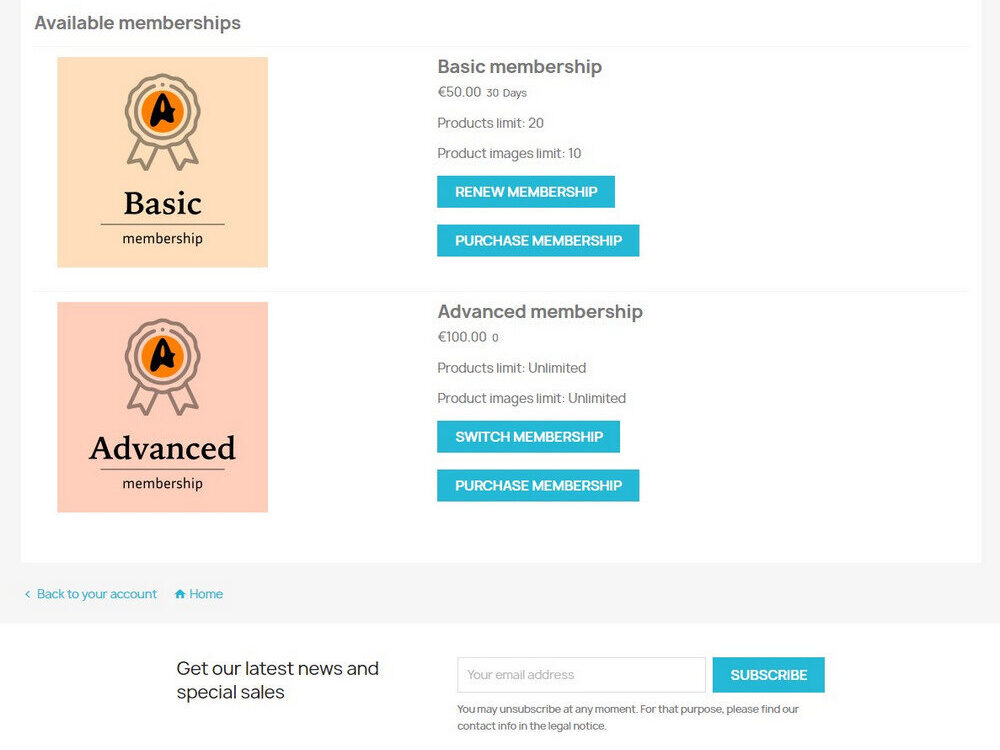“Agile Multi-Vendor Marketplace” – A Comprehensive Guide
The link to the official sales page of “Agile Multi-Vendor Marketplace” Prestashop module
Module description page: is here
In the digital age, the concept of an online marketplace is no longer a novelty but a necessity for entrepreneurs aiming to broaden their sales horizons. Platforms like Amazon and eBay have demonstrated the vast potential of harnessing multiple sellers under one virtual roof. The Agile Multi-Vendor Marketplace module for PrestaShop 8.x stands as a beacon for those seeking to transform their single-vendor stores into bustling e-commerce hubs, akin to Amazon. This article delves into the module’s compatibility, goals, and the opportunities it offers to admins, sellers, and customers alike.
Compatibility
The Agile Multi-Vendor Marketplace module is designed exclusively for PrestaShop 8.x, ensuring a seamless integration with the latest version of one of the most popular e-commerce platforms. This compatibility underscores the module’s commitment to providing a cutting-edge solution that leverages the robust features of PrestaShop.
Goal
The primary aim of the Agile Multi-Vendor Marketplace is to metamorphose a conventional store into a multi-seller marketplace. This transformation allows for a diversified product range across various categories, akin to giants like Amazon. Vendors gain the autonomy to sell products and manage orders, while the admin (or merchant) retains overarching control, including the ability to levy fees on vendors. This module is not just about expanding the product lineup; it’s about enhancing the marketplace’s functionality with options for carriers, subscriptions, product imports, and more.
Admin Opportunities
The admin’s role is pivotal in the marketplace ecosystem, with a suite of tools at their disposal:
- Marketplace Creation: Admins can easily convert their store into a marketplace, inviting multiple sellers to join.
- Seller Management: Admins have the authority to block or edit seller accounts, directly influencing the availability of the seller’s products on the platform.
- Product Oversight: Admins can manage both their products and those of the sellers, maintaining a quality catalog.
- Account Activation: The decision to manually or automatically activate new seller accounts rests with the admin, allowing for flexible administration.
- Commission Charges: Admins can impose fees on vendors, creating a revenue stream for the platform maintenance and growth.
Sellers’ Opportunities
For sellers, the Agile Multi-Vendor Marketplace module opens up a realm of possibilities:
- Account and Store Management: Sellers can personalize their store’s appearance and information, making it more appealing to customers.
- Order Management: Sellers have the capability to oversee orders, adjusting statuses and communicating with customers as needed.
- Product Portfolio Expansion: There’s no cap on the number of products a seller can list, and product information can be multilingual, depending on PrestaShop’s settings.
- Delivery Customization: Sellers can define their delivery methods, catering to their logistical preferences or constraints.
- Virtual Goods: The creation and sale of virtual products are supported, broadening the scope of what can be sold.
Customer Opportunities
Customers stand to gain significantly from the Agile Multi-Vendor Marketplace, enjoying a consolidated shopping experience:
- Diverse Product Selection: Customers can browse products from multiple sellers in a single location, eliminating the need to hop from one site to another.
- Unified Checkout Process: It’s possible to place an order with items from several sellers at once, simplifying the purchase process.
- Seller Transparency: Product pages provide information about the seller, fostering trust and transparency.
- Direct Communication: Customers can reach out to sellers directly, facilitating better communication regarding products or orders.
Conclusion
The Agile Multi-Vendor Marketplace module is a transformative tool for PrestaShop 8.x users, bridging the gap between the traditional single-vendor shop and a dynamic, multi-seller marketplace. By providing robust management tools for admins, extensive capabilities for sellers, and a streamlined, enriched shopping experience for customers, the module sets the stage for an e-commerce revolution. Whether you’re a store owner looking to scale up or a seller aiming to reach a wider audience, the Agile Multi-Vendor Marketplace presents an opportunity to thrive in the bustling digital marketplace arena.
The economic profitability of implementing the Agile Multi-Vendor Marketplace module in a PrestaShop store can be substantial for store owners. This profitability stems from several key areas, including revenue diversification, platform fees, increased traffic, and enhanced customer engagement. Here’s a breakdown of how each factor contributes to the overall economic benefit for store owners:
1. Revenue Diversification
By transitioning to a multi-vendor marketplace, store owners can diversify their revenue streams. Instead of relying solely on direct sales, they can earn from listing fees, commissions on sales made by other vendors, subscription fees for premium seller features, and even advertising fees for sellers who want to promote their products prominently on the platform. This diversification reduces financial risk and creates multiple channels for income.
2. Platform Fees and Commissions
One of the primary sources of revenue in a multi-vendor marketplace is the commission or fees charged to vendors on each sale. Store owners can set a fixed percentage or a flat rate as a commission for leveraging their platform. This fee structure ensures that as the volume of transactions on the marketplace grows, so does the income of the store owner, without the need to increase inventory or handle logistics for the additional sales.
3. Increased Traffic and Customer Base
A marketplace attracts a wider variety of products and vendors, which in turn draws a broader audience. Each vendor brings their own customer base, which contributes to increased traffic on the platform. Higher traffic enhances the potential for sales across the board, including for products directly sold by the store owner. Additionally, a larger product assortment improves the site’s SEO, making it more likely to appear in search engine results and thus attracting organic traffic.
4. Enhanced Customer Engagement and Retention
Offering products from multiple sellers provides customers with a one-stop shopping experience, which can increase customer satisfaction and loyalty. Features such as the ability to compare products from different vendors, track order status, and communicate directly with sellers enrich the shopping experience. Satisfied customers are more likely to return, contributing to a higher lifetime value per customer and more consistent revenue.
5. Scalability without Inventory Risks
Expanding a product range in a traditional e-commerce model requires significant investment in inventory, warehousing, and logistics. In a multi-vendor marketplace, however, the inventory is managed by the sellers, allowing the store owner to scale the platform’s offerings without assuming the risks and costs associated with inventory. This scalability can significantly enhance profitability, as the platform can grow and adapt to market trends and demands without necessitating a proportional increase in operational costs.
Conclusion
For store owners, the Agile Multi-Vendor Marketplace module offers a compelling opportunity to transform their PrestaShop store into a thriving e-commerce platform with multiple sources of revenue. By capitalizing on the economic efficiencies of a marketplace model—such as reduced inventory risks, diversified income streams, and enhanced customer engagement—store owners can significantly increase the profitability and sustainability of their online business. The initial investment in setting up and customizing the module can be quickly offset by the increased revenue and reduced operational costs, making it an economically viable strategy for ambitious store owners looking to scale their operations and maximize profitability.
Let’s delve into some simplified calculation examples to illustrate the potential profitability of running a PrestaShop store with the Agile Multi-Vendor Marketplace module. These examples will help highlight how various revenue streams can contribute to the overall economic benefit for a store owner.
Example 1: Commission from Sales
Assumptions:
- The store charges a 10% commission on each sale made by vendors.
- Monthly sales from all vendors amount to $50,000.
Calculation:
- Monthly commission income = 10% of $50,000 = $5,000.
Over a year, this stream alone could generate $60,000 in revenue for the store owner without the need to manage inventory or fulfill orders directly.
Example 2: Subscription Fees for Vendors
Assumptions:
- The marketplace offers a premium subscription for vendors at $100 per month.
- 50 vendors decide to subscribe to this premium service.
Calculation:
- Monthly subscription income = 50 vendors * $100 = $5,000.
This model provides a stable, predictable revenue stream, amounting to $60,000 annually, complementing the transaction-based commissions.
Example 3: Listing Fees for New Products
Assumptions:
- The marketplace charges a listing fee of $2 for each new product listed by a vendor.
- Vendors list a total of 1,000 new products each month.
Calculation:
- Monthly listing fee income = 1,000 products * $2 = $2,000.
This approach can generate $24,000 in additional revenue over the course of a year.
Example 4: Increased Sales from Enhanced Traffic and Customer Base
Assumptions:
- Before transitioning to a multi-vendor marketplace, the store’s monthly sales were $20,000.
- After the transition, the increased traffic and broader product range lead to a 50% increase in sales of the store owner’s own products.
Calculation:
- Increase in store owner’s sales = 50% of $20,000 = $10,000 additional per month.
This growth results in an additional $120,000 in sales annually, attributable to leveraging the marketplace model.
Example 5: Advertising Fees from Vendors
Assumptions:
- The marketplace offers product feature spots to vendors at $50 per product per month.
- Each month, 10 products are featured.
Calculation:
- Monthly advertising income = 10 products * $50 = $500.
Over a year, this could mean an extra $6,000 in revenue.
Combined Annual Profitability Overview
- Commission from sales: $60,000
- Subscription fees for vendors: $60,000
- Listing fees for new products: $24,000
- Increased sales from enhanced traffic: $120,000
- Advertising fees from vendors: $6,000
- Total: $270,000
These examples are simplified and do not take into account operational costs, such as hosting, marketing, and customer service, which must be deducted to calculate net profit. Additionally, the actual figures can vary based on numerous factors like commission rates, subscription levels, and the competitive landscape. Nonetheless, they underscore the potential for substantial profitability through diverse revenue streams in a multi-vendor marketplace.
The link to the official sales page of “Agile Multi-Vendor Marketplace” Prestashop module
Module description page: is here

